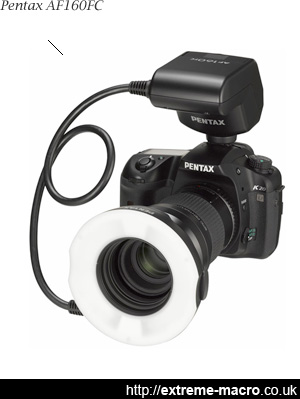Technical Tips
by Johan J Ingles-Le Nobel
Last updated August 31, 2017
Most of my macro has always been trial and error but once I adopted a couple of technical guidelines, I found that my macro photography became a lot more consistent and easier to subsequently process.
Overdose on Light
Pentax AF160FC ringflash, which floods your extreme macro shot with generous light from every possible angle. Definitely expensive, but its twin semi-toroidal flashtubes, variable light ratios, focus LEDs and PTTL functionality make it a pleasure to use for extreme macro.
Overdosing on light solves many of the problems that can occur in macro photography, especially if peering through a dark viewfinder with a reversed lens set at f/8. The problem is, I'll take a reverse shot and look at the display on the back of my camera and think great, it's just right.
But that LCD on its own on the back of your camera really is the worst thing you can judge the light levels by because these little LCDs are very bright, and have their own independent brightness controls set.
So an image that looks nice and bright on your LCD might actually be quite dark once you transfer it over to your computer to start working on it.
Although I'd refused to believe it myself, once I started changing my workflow to make sure that I was always using a histogram to judge photographs on the LCD viewfinder rather than just the display on its own, that's when the light levels became a lot brighter and a lot better to work with, to the extent that I don't even use RAW much anymore just because I don't need to.
But, horses for courses, each has their own way of doing things and RAW allows other adjustments that are difficult to achieve in-camera.
Stacking in Zerene doesn't always come out with great results especially if you've underexposed the images to any extent. Giving the light the benefit of the doubt and pushing the histogram as far to the right as reasonable without clipping detail beyond the end of the histogram has helped me stack my way out of tricky situations, making the eventual DMap and PMax processes much cleaner.
Do Everything For Detail
Everything in my workflow is geared towards obtaining as much detail out of the final picture as possible, from using in-camera sharpening settings that emphasize detail rather than sharpness, to using grazing side lighting to add a bit of texture and detail where I can, to using DMap mode as much as possible to preserve detail, to using Topaz Detail in the final postprocessing to bring out that bit extra.
The reason I mention this is that cameras for example also include such things as 'extreme sharpening' modes, but having tried them out, the shots I worked on all came out worse with those than the ones where I kept sharpening as low as possible until the very last step.
Related Articles





